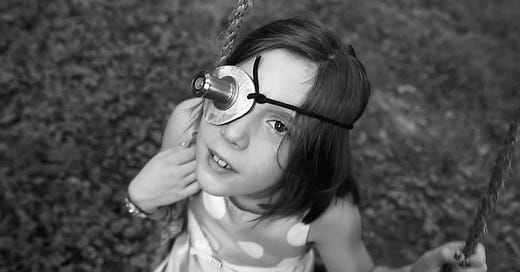(This article previously appeared in FilmThreat.)
Jim Haverkamp's lovely, surreal and poetic short, When Walt Whitman was a Little Girl is based on a prose poem by M.C. Biegner. The poem is read as a voice over in a warm simple voice by Don Henderson Baker, narrating the story of the inner life of a poet. In stylish black and white videography, we see shots of the child Whitman, portrayed here as a little girl in a polka dot dress, in a wonderful performance by Natalie Braun, who plays by herself most of the time. Why is Whitman a little white girl (with a black mother)? Is Biegner suggesting that the sensitive, homosexual Whitman had the soul of a little girl inside of him? Is the poem about all the sensitive souls, whose vision is so large and cosmic that they can identify with everyone? Is it a self portrait, using the figure of "Walt Whitman" as a screen? It may be all of these things simultaneously, but so many of the specific images in the poem, as well as the implied spiritual history of the main character, match up closely with the life and writing of the actual Whitman, that the poem certainly makes a (poetic) comment on Whitman as an artist.
The video proceeds with imagistic and suggestive sequences of action, accompanying the poem and the soft guitar music. Whitman packs a gerbil into a suitcase and throws the suitcase into the river, but she releases the gerbil first. She plays with her friend "Abe Lincoln" (with an obviously fake beard), launching potato rockets from a plastic tube. Like the real Whitman, she is devastated by the spectacle of suffering of soldiers in the war, represented here by soldiers from many conflicts, ranging from the Civil War to Vietnam and Iraq.
A special part of the video's magic are the dance sequences by Gina Kohler and James Morrow, shot in a field of snow and an abandoned shack. Their gentle, fluid duet at the climax of the film seems like Whitman's male and female selves dancing together, in a kind of balanced harmony which provides the basis for her special gift of being able to identify with all of humanity.
Neither the video nor the poem make a big deal out of the poem's fluid attitude towards gender, race, and age, which is presented in a casual and matter-of-fact manner, even though this aspect of the film might be the first thing to strike the viewer. Haverkamp is presenting a vision of the poet as an old wise soul, whether temporarily housed in the body of a girl or a grown man or a woman, whose larger vision and powers of universal empathy enables him to write poems of immense reach, where the "song of myself" becomes a song of everyone.
My articles on experimental film are freely available to all, but are supported by monthly and annual donations from readers. Please consider becoming a paid subscriber to support my work. Thank you.






Thank you very much for pointing me to this film and for your words.